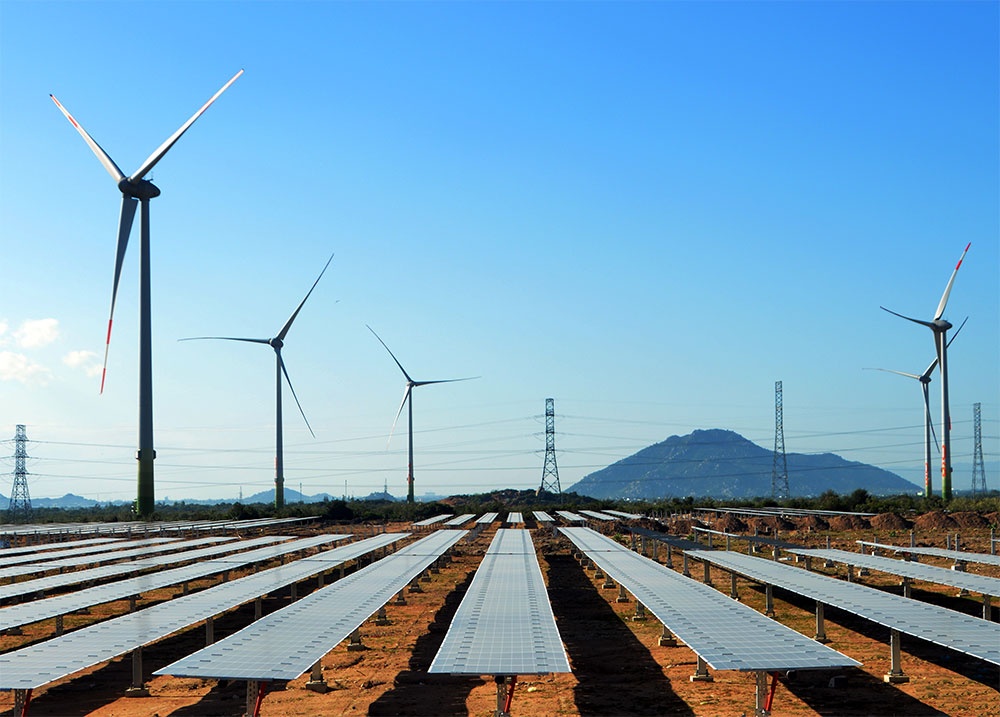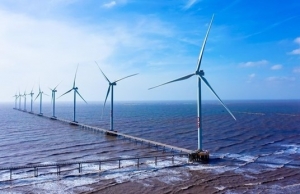Energy security deemed more likely with appropriate offshore wind strategy
Imai Masanori, president of Toda Corporation, held a meeting with the Ministry of Industry and Trade (MoIT) at the end of last December, proposing the construction of a wind measuring station in the south-central province of Binh Thuan’s waters to gain specific data on the province’s offshore wind potential. “The Japanese government has provided funds for Toda to conduct studies on the potential of offshore floating wind power in Vietnam,” he said.
“Toda can help Vietnam deal with financial problems when developing offshore wind power at seaports, or small islands, at a low cost. We are the first company licensed to produce floating wind power offshore in Japan’s deep sea, and are building a wind farm to locally produce electricity,” Masanori said.
 |
| Energy security deemed more likely with appropriate offshore wind strategy, Photo Le Toan |
Vietnam and Japan have pledged to be carbon-neutral by 2050. Vietnam, which has no experience in offshore wind power development, plans to develop 7,000MW of offshore wind power by 2030, according to the draft Power Development Plan VIII by the MoIT.
In October, Electricity of Vietnam (EVN) also proposed to the government to create a mechanism to develop about 4,000MW of offshore wind power in the north of the country to ensure electricity. The north currently accounts for nearly half of Vietnam’s electricity demand.
EVN’s updated calculations on electricity supply and demand in 2022 showed that new power sources in the north are expected to operate very little, and additional power sources are in Vietnam’s central and southern parts (mainly renewable energy) can only partially support the north as the transmission capacity through the 500kV lines is technically limited to a level that ensures safety and stability of the system.
In addition to EVN, some localities such as Quang Ninh, Ho Chi Minh City, Haiphong, Thai Binh, and Nam Dinh have asked the government to develop offshore wind power sources as more and more domestic research also leads to the possibility of wind power development.
According to a survey by the Energy Assessment Programme for Asia of the World Bank, Vietnam has the largest wind potential in Southeast Asia with an estimated capacity of over 513,000MW – 200 times the capacity of Son La Hydropower Plant and more than 10 times the total forecasted capacity of Vietnam’s electricity industry by 2020.
According to the General Department of Meteorology and Hydrology under the Ministry of Natural Resources and Environment, sea areas have the best potential for exploiting wind energy in Vietnam. In particular, the wind potential is at a “good to excellent” level in the coastal areas from Ninh Thuan to Ba Ria-Vung Tau provinces with an annual average wind speed of 8-10m/s, and an average annual energy density of 600-700W per square metre.
Cao Thi Thu Yen, renewables and environment expert at the Power Construction Consulting Company 1, said, “Vietnam has great potential for offshore wind power development thanks to its long sea route. However, exploiting these potentials depends on many factors, including development policy, and marine and coastal resources.”
Yen added that offshore wind power development in Vietnam should soon have an overall assessment, meeting the two urgent goals of power supply and policy improvement. “In Vietnam, the equipment and components for the construction and installation of onshore wind power are still mainly imported, so the price of electricity from these sources remains high,” she said.
Offshore wind power investment is decreasing rapidly but also remains high. “A 1,000MW project in Vietnam can currently cost about $3.15 billion, forecast to decrease to $2.15 billion by 2030. Offshore wind power development in Vietnam requires large investment and is dependent much on a project’s capacity, scale, and technology type,” Yen said.
Nguyen Anh Tuan, former deputy director of the Institute of Energy, said the underwater foundations of offshore wind turbines can act as artificial reefs, attracting some species of krill and fish, thus directly affecting the food chain of large organisms.
“If wind power projects do not strictly manage the undersea cables connected to the turbine towers and the power station system far away from the transmission system, many problems can occur, such as cable breaks,” Tuan warned.
He believes that offshore wind power can be a breakthrough to ensure national energy security, but must proceed to develop a national master plan on offshore wind power development.
“It’s especially important to develop supportive policies and mechanisms for offshore wind power development in association with the implementation of the Vietnam Maritime Strategy,” Tuan concluded.
| - EVN has asked the prime minister to soon consider and approve the Power Development Plan for the 2021-2030 period, with a vision to 2045, as well as amendments to Decision No.28/2014/QD-TTg from 2014 regulating the structure of electricity retail tariffs. This includes considering amending relevant decrees to create favourable conditions for state-owned enterprises to mobilise capital sources to complete the planned tasks in 2023. - The national electricity demand in 2023 is forecasted by SSI Research to dip by 5 per cent, with a GDP growth rate in the range of 6-6.2 per cent. In 2022, growth in electricity demand hit 6.4 per cent. - The World Bank forecasts that energy prices in 2023 will decrease by 11 per cent after increasing by 60 per cent in 2022 due to factors such as the Ukraine conflict and the pandemic. |
 | Vietnam offshore wind power sparks influx of foreign investment: Nikkei Asia Nikkei Asia, a news service in Japan, ran an article on January 6 saying that Vietnam's offshore wind power sparks an influx of foreign investment. |
What the stars mean:
★ Poor ★ ★ Promising ★★★ Good ★★★★ Very good ★★★★★ Exceptional
Related Contents
Latest News
More News
- Honda launches electric two-wheeler, expands charging infrastructure (January 12, 2026 | 14:00)
- Vietnam striving to ease air pollution (January 09, 2026 | 14:41)
- Petrovietnam Gas awards first multi‑year LNG deal to Shell (January 09, 2026 | 14:38)
- Advancing the net-zero journey: Carlsberg Vietnam’s sustainability progress in 2025 (January 09, 2026 | 09:49)
- The green hydrogen and ammonia future for Vietnam (January 06, 2026 | 15:03)
- Green transition to close $20 billion annual investment gap (December 31, 2025 | 11:59)
- Australia contributing to Vietnam’s climate change responses (December 30, 2025 | 11:37)
- CME Solar strengthens position in Vietnamese renewables (December 30, 2025 | 11:21)
- Self-care signals shift towards sustainable healthcare (December 30, 2025 | 10:12)
- GreenYellow marks five years of clean energy growth in Vietnam (December 26, 2025 | 15:51)

 Tag:
Tag:


















 Mobile Version
Mobile Version